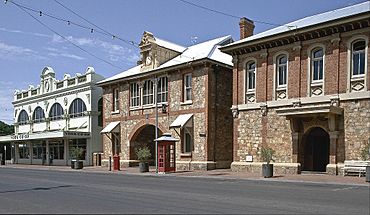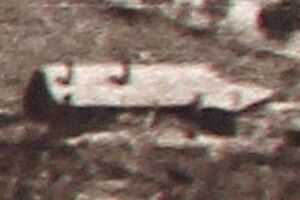Avon Terrace, York facts for kids
Quick facts for kids Avon TerraceWestern Australia |
|
|---|---|
 |
|
| Heritage buildings on the eastern side of Avon Terrace | |
| General information | |
| Type | Street |
| Length | 2.3 km (1.4 mi) |
| Major junctions | |
Avon Terrace is the main street in the historic town of York, Western Australia. It's famous for its many old, beautiful buildings. Walking along this street is like taking a trip back in time!
Contents
- Exploring Avon Terrace
- Buildings on the West Side
- Imperial Hotel
- Saint Building
- Community Resource Centre
- Sargent's Pharmacy
- Castle Hotel
- Central Buildings
- Ray White Real Estate Building
- Shops by Reginald Williams
- Jules Cafe Building
- Settlers House
- Pyke's Buildings
- York Palace Hotel
- Former Western Australian Bank
- York Fire Station
- Motor Museum Workshop
- Bank of Australasia Building
- Mongers Store
- Faversham House
- The Sandalwood Yard
- Buildings on the East Side
- Site of the First Buildings
- Site of the York Hotel
- 156 Avon Terrace
- CWA Building
- Dinsdale's Shoe Emporium
- Union Bank Building
- Home Hardware Site
- Edwards Building (IGA)
- York Post Office
- York Courthouse Complex
- York Motor Museum Building
- Bendigo Bank Building
- Collins Building
- Davies Buildings
- Former Royal Hotel Site
- Shell Garage
- Seabrook Row
- The Rabbit Shed
- York Town Hall
- Buildings on the West Side
Exploring Avon Terrace
Buildings on the West Side
Let's take a walk along the west side of Avon Terrace, starting from the Town Hall and heading north towards Ford Street. You'll see many interesting buildings with long histories.
Imperial Hotel
- The Imperial Hotel was built in 1886. It was one of the first hotels in York designed in the "Australian hotel" style. This means it had a grand look with large verandahs and a main entrance right on the street. It's built in the Victorian Filigree style, known for its fancy decorations.
Saint Building
- This building was likely built before 1917. It has been used for many things over the years. It was once a bakery, then a St John’s ambulance station, and even a café for motorcycle fans. Today, it is a private home.
Community Resource Centre
- The Community Resource Centre building used to be the office for a company called Elders.
Sargent's Pharmacy
- Obeithio Sargent built this pharmacy in 1904. Look up at the top of the building, and you'll see a mortar and pestle, which is a symbol for pharmacies. Sargent and his family lived upstairs. He even had a photography studio in the basement! A special window on the north side shows he earned the highest marks as a pharmacist.
Castle Hotel
- The newer part of the Castle Hotel was added in 1905. It's in the Federation Filigree style. The architect, William G Wolf, also designed His Majesty's Theatre in Perth. The older part of the hotel, set back a bit from the street, was built starting in 1853. It was once considered the best hotel outside of Perth.
Central Buildings
- The Central Buildings are a group of single-story shops built between 1892 and 1907. They are right next to the footpath.
Ray White Real Estate Building
- This building was built in 1908 by the Ezywalkin Boot Company. Its first tenant was a bootmaker named AJ Williams.
Shops by Reginald Williams
- The next two shops were built in 1928 by Reginald Williams, who was a butcher.
Jules Cafe Building
- The building where Jules cafe is located was built in 1908 by Mrs Jeannie Thielemann. She used it for her bakery and grocery store.
Settlers House
- Settlers House was built starting in 1861 by Henry Stevens, a blacksmith and builder. It has been used as a home, offices for a newspaper, and was restored in 1972.
Pyke's Buildings
- These are some of the oldest shops right on the footpath of central Avon Terrace. They were built by Joseph Pyke in 1885.
York Palace Hotel
- The York Palace Hotel was built in 1909 by Matthew Ryan. It was later owned by Swan Brewery and was restored in 1997.
Former Western Australian Bank
- The old Western Australian Bank building was constructed in 1889. It was designed in the Victorian Academic Classical style. More recently, it was used by Westpac Bank until 2019.
York Fire Station
- The York Fire Station is a red brick building. It was first built in 1897 as the Council Chambers for the York Municipal Council. It's in the Federation Free Classical style. Today, this building is a bookshop.
Motor Museum Workshop
- This building was built around 1912. It was used as a metal workshop and even by the army during World War II. Now, it's a workshop for the York Motor Museum.
Bank of Australasia Building
- The Bank of Australasia building, north of Harvey Street, was built in 1900 in the Federation Romanesque style. It has been used as a dentist's office, a chemist, a funeral home, and is now a residence.
Mongers Store
- Mongers Store was finished in 1879 for John Monger Jr. It was made of corrugated iron with stone at the front and back. Later, it was bought by the York Co-operative and used for welding.
Faversham House
- Faversham House is a large, grand home across the railway line. It was built in different stages by John Henry Monger Snr and his family.
The Sandalwood Yard
- The Sandalwood Yard was first used in the 1840s. The stone building there was probably an original store, built between 1839 and 1843. It was used to store food for horses. Today, the York Society uses it. Inside the yard, you can see a rebuilt Tipperary school house.
Buildings on the East Side
Now, let's walk along the east side of Avon Terrace, heading south from Ford Street back towards the Town Hall.
Site of the First Buildings
- The empty block on the corner is where the very first buildings in York were located in 1831.
Site of the York Hotel
- The empty block further south was the site of the "new" York Hotel, built in 1865. It operated as a hotel until the 1920s. You can see a plaque with a picture of the old building. Before that, two earlier York Hotels stood here, with the first built in 1837. The last part of the York Hotel still standing is the billiard room, built in 1893.
156 Avon Terrace
- Number 156 Avon Terrace was the very first piece of land granted in the town center in 1843. At the back, on Christie Retreat, is the oldest building in the town center, built in 1841 as a blacksmith's shop. It was later a coach house, stables, a pub, and a boarding house. The main building at the front was built in 1869. It was once leased to the Union Bank of Australasia, the first bank in York. Later, it became a restaurant and boarding house called Penola House. Since 1942, it has been a private home.
CWA Building
- The CWA building (No 154) was built in 1856 as a butcher’s shop. It was later owned by the resident magistrate, Captain Richard Goldsmith Meares. It was also used as a store and a taxi business. In 1953, the Country Women’s Association bought it.
Dinsdale's Shoe Emporium
- Dinsdale's Shoe Emporium (No 152) was built in 1887 by William Dinsdale, who made boots and saddles. You can still see parts of his original sign on the front of the shop! The architect was James William Wright. The shop was restored in 2019 and is now a gallery. It even has the original 1887 shop counter.
Union Bank Building
- The Union Bank building (1900) was designed in the Federation Romanesque style. It still has its original public banking area inside. The building also includes a home for the bank manager, set back from the street.
Home Hardware Site
- Home Hardware is located where Solomon Cook’s flour mill used to be, from 1850 to about 1900.
Edwards Building (IGA)
- The Edwards Building, now the York and Districts Co-operative Ltd (IGA), is a large store built in 1882. The front of the building was updated in 1893. Notice the fancy decorations on the front!
York Post Office
- The York Post Office (1895) is the oldest two-story post and telegraph building still standing in Western Australia. It was designed as part of a group of important town buildings. It's in the Federation Free Style, which is a type of Arts and Crafts style.
York Courthouse Complex
- The York Courthouse Complex was built between 1852 and 1896. It includes old prison cells from the time when convicts were sent to Australia. The front parts of the building were designed as part of the town's important civic buildings. It's also in the Federation Free Style.
York Motor Museum Building
- The York Motor Museum building was built in 1908. Today, it houses a fantastic collection of cars and other vehicles.
Bendigo Bank Building
- The Bendigo Bank building is one of the few modern buildings on Avon Terrace. It was originally built by the CBC Bank.
Collins Building
- The Collins Building was constructed in 1907. It has shops on the ground floor and offices above.
Davies Buildings
- The Davies Buildings were built in 1908. They had shops on the ground floor and extra rooms for guests of the Castle Hotel upstairs. A special two-faced clock was added around 1950. It cost a lot of money, but it had to be silenced at night because hotel guests complained about the chimes!
Former Royal Hotel Site
- The empty block after South Street is where the Royal Hotel used to stand. It was torn down after the 1968 Meckering earthquake.
Shell Garage
- The Shell garage was built in 1926. It's the second oldest Shell garage in Australia that has been in continuous use!
Seabrook Row
- Seabrook Row is a group of four shops.
The Rabbit Shed
- The Rabbit Shed was built around 1920. It had cold storage for rabbit skins during the time when there were many rabbits in Australia.
York Town Hall
- When it was built in 1911, the York Town Hall was one of the largest public halls in Western Australia. It was built during a time of grand and fancy architecture. The building is in the Federation Mannerist style, with exaggerated classical features. The architect was James William Wright.

All content from Kiddle encyclopedia articles (including the article images and facts) can be freely used under Attribution-ShareAlike license, unless stated otherwise. Cite this article:
Avon Terrace, York Facts for Kids. Kiddle Encyclopedia.

